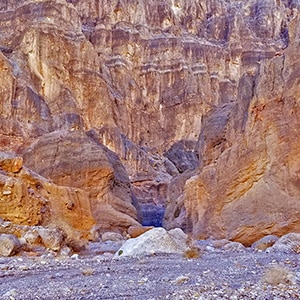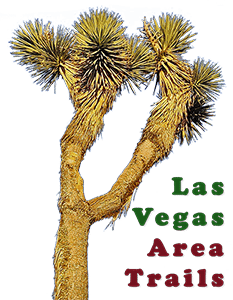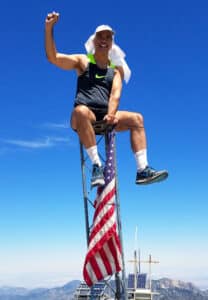Fall Canyon in Death Valley National Park is the wilder, lesser known neighbor just a short walk to the North of the more popular Titus Canyon. Unlike Titus Canyon you cannot drive through Fall Canyon. However, the show stopper here are the towering cliff walls surrounding you in Fall Canyon. Many of the walls have brilliant stripes and designs composed of orange and black dolomite and limestone, referred to as Banded Bonanza King formations. Alternately there are narrows with high walls smoothed by the rushing water and rocks from past flash floods. In addition there are what I refer to as “The Hanging Gardens of Fall Canyon” as you pass between cliffs decorated with hanging plants seemingly growing out of the solid rock walls.
Fall Canyon can be divided into a lower and an upper section. The lower section is about a 6-mile round trip from the trailhead at the Titus Canyon parking area. This section of Fall Canyon is very easy to navigate. For the entire stretch you are in a wide canyon wash with a gradual steady incline. There are virtually no obstacles to navigate save one fairly steep gravelly 40-50ft descent into the Fall Canyon Wash. Otherwise, if you don’t mind the gravel which at times can get a little deep and a few occasional shallow steps you will have no trouble navigating lower Fall Canyon up to the point you are brought to a sudden stop by a 20ft vertical dry waterfall (pour over) with walls so smooth there’s no way to ascend without a rope.
However, there is a hidden and somewhat technically complicated bypass route requiring a little class 4 climbing skills, a good pair of climbing shoes and, recommended, a climbing partner to spot you and help you over a 6-10ft near vertical wall and an exposed stretch above. This is your access to the upper section of Fall Canyon.
On my first pass, I did not go beyond the end of Lower Fall Canyon but did scope out the cliff bypass route from below in detail. This is documented in the video on this page. At some point I will return to adventure in upper Fall Canyon, which I hear is even more spectacular than lower Fall Canyon.
I recommend you set aside an entire day if you intend to experience both lower and upper Fall Canyon and bring a climbing partner. In addition, plan this adventure between late Fall and mid Spring as temperatures can easily rise above 120 degrees in the Summer months. As this was my second adventure of the day I turned around at the top of Lower Fall Canyon.
From Las Vegas take Hwy 95 North to Beatty, Nevada. At Beatty Nevada take Hwy 394 (Daylight Pass Road) toward Death Valley National Park. At the bottom of the road where it “Ts” out, take a right onto Scotty’s Castle Road and travel about 15 miles to the Titus Canyon turnoff on your right. Drive the 3-mile unpaved, but fairly well graded and maintained road to the Titus Canyon parking area and then navigate to the next canyon to the North of Titus Canyon. This is Fall Canyon. Take a right in that canyon wash and head into the entrance of Fall Canyon.
At the parking area for Titus Canyon you’ll notice an obscure but definite trail branching off from behind the rest room. Take this fairly obvious trail for about a half mile North along the base of the Grapevine Mountains. It’s hard to get lost as long as you stay just below the rocky cliffs at the base of the mountains.
In about a half mile you’ll be confronted with a ridge composed of the hardened composite rock material that washes down from the canyons above. It’s only a short walk up to the summit of the ridge but at the upper edge you’ll see it’s quite a plunge about 40ft downward into the base of the Fall Canyon Wash. If you stick to the trail, when you reach the top of the ridge there is a fairly steep loose rock chute to descend into the wash below. I noticed that just a few feet to the right of the steeper trail most people take there is a natural, a bit more gradual, waterway heading downward into the Fall Canyon Wash.
There is a much more gradual descent from the top of the ridge into the Fall Canyon Wash. To locate this alternate route, instead of descending into the wash when you first come to the ridge, take a right (East) and continue along a wash just below the ridge. There is a fairly well traveled use trail that skirts the ridge for about 1000ft and then heads over the ridge more gradually and down into the Fall Canyon wash below.
Either way, it’s fairly easy to navigate into the Fall Canyon wash where you take a right (East) and head about 1/8th mile to the mouth of Fall Canyon. Once in Fall Canyon navigation is easy. There’s only one choice: Stay in the canyon wash. Turn around often to watch for the sunlight hitting the colorful banded cliff walls at just the right angle for the best photography. The cliff walls will alternately be banded and smooth. Note the amazing mosaic designs composed of hardened smooth composite rock and designs composed of extensive intricate mineral veins in the solid rock.
About half way to the top of lower Fall Canyon there are two interesting side canyons: One splits off to the right and the other just 20-30ft beyond, splits off to the left. There are no other possible deviations to take in lower Fall Canyon.
Not long after the intersection with the side canyons, Fall Canyon opens up, the sun bathes the canyon and more plant life appears. Here is a grand view of a huge colorful banded mountain side immediately ahead. Then the canyon narrows a bit and you begin to pass through the hanging cliff gardens of Fall Canyon.
Not long after the last stretch of hanging gardens you are brought to a sudden stop at the 20ft vertical dry waterfall (pour over) that marks the end of lower Fall Canyon. You’ll see in the video on this page how I retrace my steps back down the canyon for 3-500ft in search of the entrance of the cliff bypass route which I ultimately identify and document in the video. There is only one potential bypass route in the class 3-4 level of rock climbing. The rest of the area is pretty solid impassible vertical canyon walls except for a very experienced, confident well equipped class 5 rock climber.



Return often to experience one new adventure each week! From the home page scroll to “Most Recent Adventures“. More about David Smith…
The trail adventures on this website require proper conditioning, preparation and safety precautions. There are many factors beyond our control including weather conditions, unstable ground, loose rocks, insects and snakes, people you may encounter, your own level of physical conditioning, the potential of getting lost just to mention a few. While this site offers guidance, helpful tips, direction and training, the reader assumes full responsibility for whatever may occur during their trail adventure. Have fun and be safe!